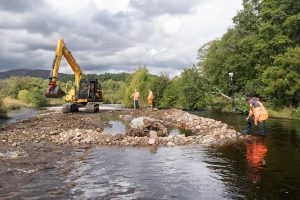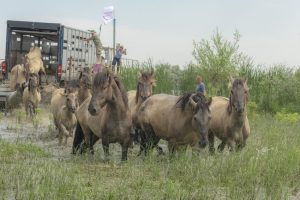What is the role of funders in supporting the effectiveness of a sector? In the last few years, a group of conservation funders has been considering effectiveness in the light of evidence and adapting their processes to encourage the use of evidence in planning and delivery of conservation projects.
Tree nursery volunteering – Cairngorms Connect
Readers will no doubt be aware of the huge variability in the effectiveness of the initiatives funders support: some are very successful while others are not. These funders think that one part of that puzzle is ensuring that the initiatives they fund build, as far as possible, on the experiences of others.
The journey started with The Whitley Fund for Nature, which helps scale up established small conservation projects. As part of selecting which projects to fund, the Whitley team compared proposals against existing evidence and identified projects that were well supported or where previous studies showed the suggested actions were unlikely to work.
While this was a step in the right direction, it required substantial staff time and did not allow applicants the opportunity to improve their proposals, if needed, once they had consulted existing evidence. As a result, in 2016 Whitley changed tack. They developed a new approach of asking applicants to reflect on why their project was likely to succeed, on the basis of any existing evidence they had identified.
This process has since been adopted by a number of other organisations ranging from small funders to governments. Twenty-five of these funders came together last year and published a letter in a leading conservation journal (‘Funding evidence-based conservation’) outlining the importance of asking applicants to reflect on the evidence, and providing a set of ten different potential approaches to doing this. The letter appendix provided a practical framework describing how evidence could be included in grant application forms.

Woody material in the River Tromie – Cairngorms Connect
Building on these ideas, and alongside the group Conservation Evidence, we convened a workshop at the Cambridge Conservation Initiative on 28 February for thirty funders interested in using evidence to increase their effectiveness. Julien Semelin, Head of Environment Investments at Cartier for Nature, began by describing why Cartier considered evidence use as critical. This included improving efficiency and creating effective projects that can then leverage further funding. The group then heard from a series of funders describing the approaches they had adopted.
Some funders (e.g. People’s Trust for Endangered Species) ask applicants to outline the evidence base for their proposed intervention when they first apply; others (e.g. Endangered Landscapes Programme) wait to discuss the evidence available at a later stage of the application process. Several encourage applicants to think about different types of evidence, whether peer-reviewed, expert opinion (including local knowledge), grey literature or personal experience, and then weigh up the importance of each themselves. This approach allows for a range of evidence bases to be considered, from indigenous knowledge (such as ‘right-way science’) to the results of randomised controlled tests. The aim is to encourage reflection on the existing evidence, for example by considering its quality and relevance to the proposed project.
Many of these approaches are still at an early stage but several funders felt that asking about evidence had improved their application process; others shared lessons learned and relayed how they were adapting and improving their processes. Some participants expressed reservations about the approach, in particular the potential for Western science to dominate other forms of knowledge.
There are, of course, millions of journal articles with conservation findings, as well as a huge body of grey literature (e.g. reports) from conservation organisations and others that detail evidence of what works and what doesn’t. It would be impossible for applicants or funders to read it all! Tools out there can help, however. The open access Conservation Evidence website provides summarised evidence for thousands of conservation actions (filtered from 1.6 million paper titles in 17 languages). Previous workshops bringing together conservation practitioners, funders and researchers have also created a series of tools for assessing and embedding evidence into practice, summarised in the open access book Transforming Conservation: a practical guide to evidence and decision making.

Release konik horses – Andrey Nekrasov/Rewilding Ukraine
The benefits of using evidence in funding decisions were two-fold: enabling funders to identify the projects that are likely to deliver, and incentivising applicants to thoroughly explore the viability of proposed options when planning projects. More broadly, we believe this could precipitate a sea change in conservation effectiveness, as practitioners routinely check for evidence when planning any project.
One concern raised at the February workshop was whether asking funding applicants to provide the evidence base for their proposals could suppress innovation or discourage work on understudied species, issues or locations, where little or no previous evidence exists. The consensus among the funders was that new ideas should be welcomed; in these cases, applicants should be encouraged to design projects that will collect data on the outcomes of these understudied actions and share the results, thereby building the collective evidence base. Bill Sutherland of Conservation Evidence raised an example of how not to do this in bat bridges – these started as a reasonable, novel idea to reduce vehicle collisions with bats, then moved into best practice, without an intervening process of testing: subsequent studies by academics showed that these structures are not effective in reducing bat mortality.
We are well aware that using evidence is not without its challenges, as conservation deals with many complex and ‘wicked’ problems. Some participants in the workshop were concerned that funders and Western conservation practitioners would give primacy to Western academic and practitioner evidence over other forms of traditional or culturally-specific knowledge. Trust in different types of evidence may vary from person to person, and decision-making needs to find ways to combine scientific evidence of different kinds with values and local experience. Attendees acknowledged that there is much more to do in this area, particularly around community-based conservation and policy-making.

Non-native removal – Cairngorms Connect
The MAVA Foundation has been contributing to this dialogue as it draws to a close in June 2023 with its series of learning reports. With much of MAVA’s funding directed towards organisational support, networks and conservation aimed at changing attitudes and policies, they have much to offer by way of reflecting on the evidence base for more complex approaches to conservation. The Conservation Learning Initiative combined evidence from grantee reports with the wider published evidence base to learn lessons about a number of key conservation strategies including capacity building, forming partnerships and alliances, providing flexible funding, and supporting research and monitoring. The lessons learned have immediate relevance to the wider conservation community, while the approach to learning that was developed can serve as a template to answer a range of future important questions.
From the enthusiasm at the workshop and the progress made in the last few years, it seems there is a real appetite for improving the efficiency of practice. The workshop resulted in more funders deciding to ask applicants to reflect on the evidence and allowed those that are doing this already to share their experiences and work together to improve processes for evidence checking. Next steps identified include the formulation of standard questions that any funder can use to ask applicants about the evidence for their proposed work and the development of approaches by which funders can encourage the testing of actions to generate new evidence. The hope is that evidence checking will become a routine part of project planning, resulting in more effective conservation and increasing standards, attracting further funding into conservation.
A recording of the meeting is available here:
Florence Miller is the director of The Environmental Funders Network, which convenes a group of over 200 different trusts, foundations and individual donors to support their effective environmental giving. Nancy Ockendon is the Science Manager of The Endangered Landscapes Programme, funded by Arcadia.
Credit:Source link




